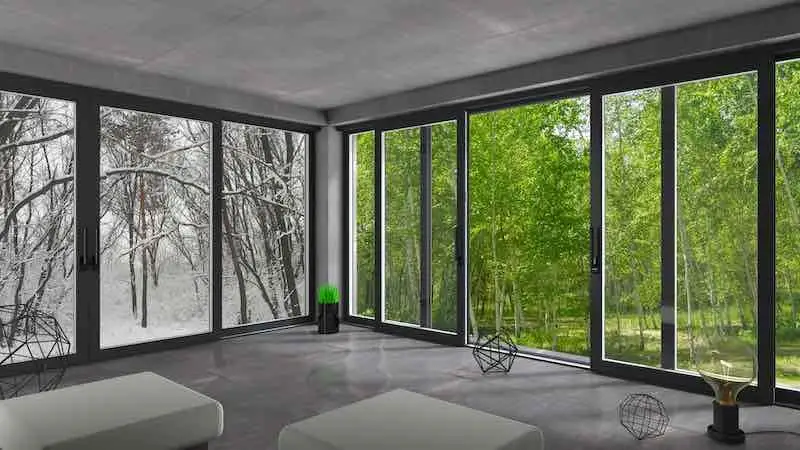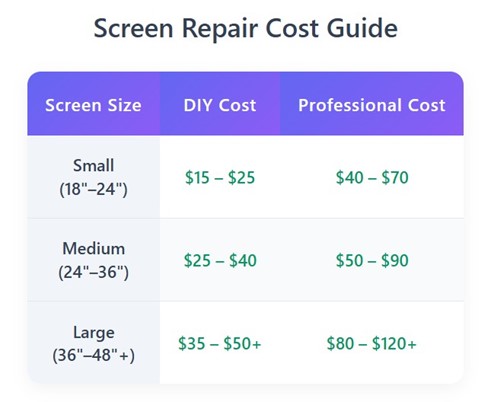Window Screen Cost 2025 Guide + Pro Tips

In 2025, the window screen replacement cost ranges between $30 and $120 per screen, with several factors affecting the final price. These include the screen material type, the window screen cost per size, whether you choose a DIY approach or opt for professional screen installation pricing, and the overall scope of your home project.
Let’s break down the window screen pricing 2025 to give you a more accurate home window screen cost estimate based on service type:
Key Pricing Factors Explained
DIY vs. Professional Installation
If you’re on a budget, going the DIY route can significantly reduce your window screen replacement cost. With the right tools and materials, you can expect to spend $15–$50 per screen, especially for standard sizes and basic fiberglass mesh. This makes the DIY window screen cost a great option for homeowners who are comfortable with light home repairs.
However, DIY projects can be time-consuming and may not offer the same long-term durability as professionally installed screens. For custom sizes, premium materials, or multi-story homes, hiring a pro is often the smarter choice. The professional screen installation pricing in 2025 typically ranges from $50 to $120 per screen, depending on your location and the complexity of the job.
Screen Repair vs Replacement: Which Makes More Sense?
One of the most common questions homeowners ask in 2025 is whether to repair a damaged window screen or replace it entirely. With rising window screen replacement cost, it’s important to weigh your options carefully based on the damage type, screen material, and long-term value. Choosing between screen repair vs replacement ultimately depends on the severity of the issue and your specific needs.
When Screen Repair Makes Sense
If the screen frame is intact and the mesh has only minor damage, repair is often the most cost-effective and quick solution. This approach helps you save money while extending the life of your screens. Wondering how much to fix window screen damage? Minor repairs typically cost $10–$40 per screen, depending on the size and material.
You should consider repair if:
- You have small holes or tears in the mesh
- The spline (the rubber seal that holds the mesh in place) is loose or worn
- The frame is not bent, rusted, or broken
- You’re working with standard sizes and common mesh types like fiberglass
- You’re looking for a fast, low-cost fix to maintain functionality
If you’re handy, the DIY window screen cost for repair can be as low as $5–$20, making it a great budget option for small issues.
When Replacement Is the Better Option
While repairs may be inexpensive, they aren’t always the smartest long-term solution. If the screen frame is warped, the mesh is severely torn, or the screen has been previously repaired multiple times, it may be more practical—and even cheaper in the long run—to invest in a new screen. In 2025, window screen pricing for full replacement ranges from $30 to $120 per screen, based on factors like material, size, and labor.
You should choose replacement if:
- The screen frame is bent, corroded, or damaged
- The mesh is outdated, brittle, or made from low-quality material
- There are multiple tears or previously patched sections
- You want to upgrade to a better material (e.g., aluminum, solar mesh)
- You need custom-sized screens or want a more durable, long-lasting solution
Modern materials such as aluminum, stainless steel, and solar mesh not only enhance durability but also improve home efficiency. Choosing the best window screen material cost option might cost more upfront, but it can save you money on energy bills and maintenance down the line.
Pro Tip: Know When to Upgrade
If your current screens are more than 8–10 years old, consider a full upgrade even if they look “fixable.” Older screens may have brittle mesh, weak spline channels, or frames that no longer sit flush in the window. Upgrading gives you access to modern materials like:
- Pet-resistant mesh
- Solar/UV filtering screens
- Heavy-duty aluminum or steel mesh
- Custom-tinted screens for privacy and glare reduction
Yes, this adds to the window screen replacement cost, but it improves the overall value, energy efficiency, and aesthetics of your home.
Material Selection
The type of screen mesh you choose has a direct impact on cost and performance. For example:
If you’re comparing options, the best window screen material cost isn’t just about the cheapest price—it’s about durability, function, and long-term savings. Solar mesh, for example, can help reduce cooling costs, while aluminum stands up better in areas with active pets or rough weather.
Window Screen Cost Per Size
Size is another major price driver. Standard sizes are more affordable, while oversized or specialty windows may require custom fabrication. Here’s a breakdown of what to expect:
If you’re looking for an accurate home window screen cost estimate, measure each window and calculate based on the screen size and desired material. Remember to factor in installation costs if hiring a professional.
How to Get the Best Deal on Window Screens in 2025
With rising material and labor costs, homeowners in 2025 are increasingly looking for smart ways to save money on window screen repair and replacement without sacrificing quality. Whether you’re replacing a single screen or updating your entire home, following a few strategic tips can significantly reduce your total window screen replacement cost. Below are five proven strategies to help you get the best possible value.
1. Compare Material Options Carefully
One of the biggest factors that influences window screen pricing in 2025 is the type of material you choose. While fiberglass remains the most common and affordable mesh (typically $20–$40 per screen), other materials offer better performance in specific environments:
- Aluminum screens are more durable than fiberglass and resist corrosion, making them ideal for homes in windy or pet-prone areas. They cost slightly more ($25–$50) but last longer.
- Stainless steel mesh is rust-resistant, ultra-strong, and perfect for coastal regions or storm-prone zones. Though more expensive ($50–$100), it’s the best long-term investment for harsh conditions.
- Solar or UV-blocking mesh can reduce indoor heat and protect furniture from sun damage, offering both comfort and energy savings.
If you’re unsure which mesh is right for you, request samples or consult a local provider. Always weigh the best window screen material cost against your location, climate, and long-term maintenance goals.
2. Bundle Replacements for Bigger Savings
If you have several damaged or aging screens, replacing them all at once can lead to major discounts. Many installers offer bundle pricing when working on 5 or more windows in a single visit.
For example:
- Replacing 1 screen individually may cost $90.
- Replacing 5 screens as a package might bring the cost per screen down to $60–$70.
This approach also minimizes labor fees, travel charges, and downtime. Plus, it gives your home a uniform, fresh appearance—especially if you’re upgrading all screens to a modern mesh type. If you’re planning a whole-home update, request a home window screen cost estimate with a breakdown by quantity and screen type.
3. Schedule Your Project During the Off-Season
Most people think about screen repair and replacement in the spring and summer—right when demand (and prices) are highest. If you’re not in a rush, try to schedule the job during the off-season: late fall through winter.
Benefits of off-season installation:
- Shorter wait times for appointments
- Lower professional screen installation pricing
- Better contractor availability for larger projects
- More willingness to negotiate on price or offer upgrades
Some providers even run seasonal promotions, making this one of the best ways to reduce your window screen replacement cost without cutting quality.
4. Ask About Warranties and Service Guarantees
Before agreeing to any professional work, ask if the job includes a warranty. Many reputable screen installation companies offer 3 to 5 years of coverage on materials and labor, particularly if you’re opting for high-grade mesh or custom work.
A warranty can protect you from:
- Premature tearing or sagging mesh
- Faulty frame construction
- Installation issues (e.g., poor tension, misalignment)
Always get warranty terms in writing, and ask whether it includes free repairs or full screen replacements. While this might not lower your initial window screen cost, it can save you hundreds over time in avoided repair expenses.
5. Research and Compare Local Providers
Labor costs and availability vary widely by region, which can dramatically affect your window screen pricing in 2025. Before hiring a company, get at least 2–3 detailed quotes. Be sure to ask the following:
- Is the quote all-inclusive (materials, labor, travel, removal of old screens)?
- What type of mesh is included by default?
- Are there additional charges for custom sizing or shaped windows?
- Can they provide customer references or reviews?
Don’t just go with the cheapest option—look for a balance between experience, fair pricing, and quality materials. Also, check if your provider offers advice on screen repair vs replacement, which can help you avoid unnecessary full replacements.
Final Thoughts
Window screen replacement may not be the flashiest home upgrade, but it offers huge returns in comfort, energy savings, and aesthetics. Whether you’re handling it yourself or calling the pros, knowing the current window screen replacement cost helps you budget smartly and avoid overpaying.








